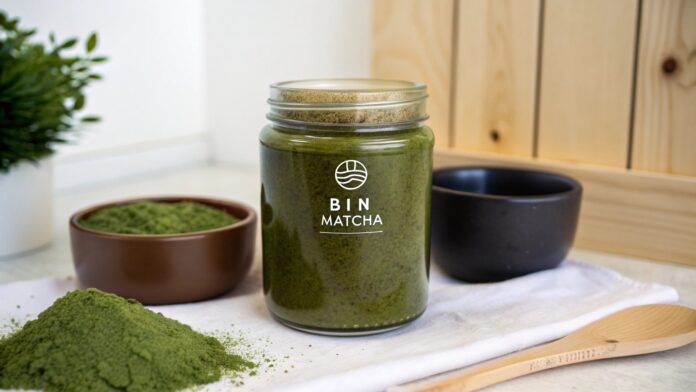Bin Matcha is a special type of Japanese green tea powder that has been aged or stored for a period of time to enhance its flavor. Unlike fresh matcha, which is known for its sharp, grassy taste, Bin Matcha offers a smoother, milder flavor with natural sweetness. The word “Bin” in Japanese translates to storage or container, which highlights the process of aging the tea carefully to develop its taste over time.
Many tea enthusiasts around the world are discovering Bin Matcha for its unique flavor and versatility. While fresh matcha is often reserved for traditional Japanese tea ceremonies, Bin Matcha has gained popularity in everyday beverages, cooking, and even desserts. The aging process makes it more approachable for beginners who find fresh matcha too bitter or intense.
Bin Matcha also represents a bridge between traditional Japanese tea culture and modern culinary use. It provides tea lovers a way to enjoy authentic flavors without the sharpness that may overwhelm the palate.
Meaning of “Bin” in Bin Matcha
The term “Bin” literally means storage, container, or bin in Japanese. In the context of matcha, it indicates that the tea has been stored or aged for a period after processing. This process allows the tea leaves to settle, reducing bitterness and enhancing umami, sweetness, and earthy flavors.
In Japan, the aging of tea is a careful art, involving precise temperature, humidity, and timing. The controlled storage allows delicate chemical changes to occur in the tea, giving Bin Matcha its characteristic smoothness.
In Western markets, Bin Matcha is often labeled as “aged matcha” or “culinary-grade matcha.” This helps consumers distinguish it from ceremonial-grade fresh matcha, which is primarily used in traditional tea ceremonies. The concept is similar to aging cheese or wine: time improves flavor while maintaining quality.
The Production Process
Bin Matcha starts with high-quality tea leaves, usually from Japan’s premium tea regions such as Uji, Nishio, and Shizuoka. After harvesting, the leaves are steamed to prevent oxidation, dried, and finely ground into powder.
Unlike fresh matcha, Bin Matcha undergoes a period of storage, sometimes ranging from several months to over a year. During this aging period, the chemical components in the tea leaves subtly change. Chlorophyll slowly breaks down, while catechins (which are responsible for bitterness) reduce, leading to a smoother, sweeter taste. Amino acids, particularly L-theanine, become more prominent, contributing to the tea’s natural umami and mellow flavor.
Controlled aging ensures that Bin Matcha retains its vibrant green color, while its flavor develops a nutty, earthy aroma. Many producers also test the powder regularly to ensure consistent quality and flavor before releasing it to the market.
Difference Between Bin Matcha and Fresh Matcha
The main differences between Bin Matcha and fresh matcha can be observed in flavor, aroma, usage, and price:
| Feature | Fresh Matcha | Bin Matcha |
| Flavor | Strong, grassy, sometimes bitter | Smooth, sweet, nutty |
| Aroma | Fresh, vegetal | Warm, earthy, complex |
| Use | Traditional tea ceremonies | Beverages, baking, daily drinks |
| Price | Higher (ceremonial-grade) | Moderate, accessible |
| Shelf Life | Short (use quickly) | Longer, designed for storage |
Fresh matcha is ideal for purists who want the authentic ceremonial experience, while Bin Matcha is suitable for everyday enjoyment. The smoother, nutty flavor of Bin Matcha makes it easier to blend with milk, fruits, and other ingredients, expanding its culinary versatility.
Grades and Types of Bin Matcha
Bin Matcha is available in several grades, which cater to different purposes:
- Culinary-grade Bin Matcha
Culinary-grade Bin Matcha is specifically designed for cooking and baking. It has a smooth, approachable flavor and can be added to lattes, smoothies, cookies, cakes, and ice cream without overpowering the dish. - Premium-aged Bin Matcha
This grade is slightly higher in quality and can be used for drinking as well as culinary purposes. It has a more balanced aroma, a richer taste, and is often chosen by enthusiasts who want both flavor and smoothness. - Ceremonial Bin Matcha (Limited)
Rarely, some producers create aged matcha suitable for ceremonial use. These are carefully aged while maintaining the delicate aroma required for traditional tea ceremonies.
Choosing the right grade depends on how you plan to use the tea. For example, culinary-grade is perfect for lattes and desserts, while premium-aged Bin Matcha can be enjoyed as a traditional tea drink or used in high-end recipes.
Health Benefits of Bin Matcha
Bin Matcha, like all matcha powders, is packed with antioxidants, amino acids, and vitamins. Its health benefits include:
- Rich in antioxidants: Helps neutralize free radicals and supports overall cellular health.
- Boosts metabolism: L-theanine and natural caffeine help improve energy and fat metabolism.
- Supports heart health: Regular consumption can contribute to lower cholesterol levels.
- Improves mental focus: L-theanine promotes calm alertness, reducing stress and enhancing concentration.
- Enhances immunity: Contains vitamins A, C, and E, which strengthen the immune system.
The aging process does not significantly reduce these nutrients, but it does improve the flavor, making it more enjoyable for daily consumption without added sugar or flavorings.
How to Prepare Bin Matcha
Bin Matcha is versatile and easy to prepare. You can make traditional tea or modern beverages:
Traditional Preparation:
- Sift 1–2 teaspoons of Bin Matcha into a bowl.
- Add 2–3 ounces of hot water (around 80°C / 176°F).
- Whisk using a bamboo whisk (chasen) until frothy.
- Enjoy immediately to savor its aroma and smooth taste.
Modern Preparation:
- Mix 1–2 teaspoons of Bin Matcha in hot or cold milk (dairy or plant-based).
- Sweeten optionally with honey, sugar, or syrup.
- Blend or whisk until smooth.
- Serve as a latte, smoothie, or iced drink.
Its mild flavor allows experimentation, including adding spices, vanilla, or fruits.
Uses in Beverages
Bin Matcha is very versatile for beverages:
- Matcha Lattes: Both hot and iced, with milk or milk alternatives.
- Smoothies: Mix with fruits, yogurt, or protein powders.
- Iced drinks: Refreshing with ice cubes and a splash of milk or water.
- Traditional Matcha: Whisked in a bowl for a ceremonial-like experience at home.
The nutty, earthy flavor of Bin Matcha balances well with sweetness, milk, and fruits. This makes it ideal for people who want a mellow green tea experience.
Uses in Cooking and Baking
Bin Matcha adds both color and flavor to many recipes:
- Cakes and muffins: Gives natural green color and mild flavor.
- Cookies and pastries: Smooth taste complements sweet baked goods.
- Desserts: Ice cream, mousse, pudding, and parfaits.
- Savory dishes: Occasionally used in pasta, sauces, or salad dressings.
Its mellow flavor makes it easier to blend with other ingredients, unlike fresh matcha, which can taste strong and sometimes bitter.
Storage and Shelf Life
Even though Bin Matcha is aged, proper storage preserves its flavor and color:
- Keep in an airtight container to prevent oxidation.
- Store in a cool, dry place away from sunlight, or refrigerate for longer shelf life.
- Avoid moisture and always use a dry spoon.
- Use within 6–12 months after opening to enjoy optimal flavor.
By following these storage tips, Bin Matcha remains fresh, vibrant, and aromatic for months.
Buying Tips and Price Comparison
When buying Bin Matcha:
- Look for reputable brands that mention storage and aging periods.
- Culinary-grade is suitable for cooking, premium-aged for drinking.
- Compare online and offline prices; Bin Matcha is generally more affordable than ceremonial-grade fresh matcha.
- Check reviews for flavor, aroma, and color quality.
Investing in high-quality Bin Matcha ensures the best taste and health benefits while providing versatility in both beverages and cooking.
Why Bin Matcha is Gaining Popularity
Bin Matcha has become popular globally for several reasons:
- Smooth and approachable taste – Easier for beginners to enjoy.
- Versatile in use – Suitable for lattes, smoothies, desserts, and traditional tea.
- Affordable alternative – Offers authentic Japanese matcha experience at lower cost.
- Health benefits – Rich in antioxidants, L-theanine, and vitamins.
- Longer shelf life – Aging increases flexibility in storage and use.
Its mild, sweet, and nutty flavor has made it a favorite among tea lovers, baristas, and home cooks.
Conclusion
Bin Matcha is a unique and versatile form of Japanese green tea that offers smooth, nutty, and slightly sweet flavors due to its aging process. Unlike fresh matcha, it is more approachable, affordable, and suitable for both drinking and cooking. With proper storage and preparation, Bin Matcha can become a daily favorite, adding both flavor and health benefits to your routine. Whether for traditional tea ceremonies, modern beverages, or culinary creations, Bin Matcha provides a rich experience that appeals to all tea enthusiasts.
FAQs about Bin Matcha
Q1: What is Bin Matcha?
A: Bin Matcha is aged Japanese green tea powder with a smoother, sweeter, and less bitter taste compared to fresh matcha.
Q2: How is Bin Matcha different from fresh matcha?
A: Bin Matcha is stored or aged after processing, which reduces bitterness and enhances umami, while fresh matcha is more intense and grassy.
Q3: Can Bin Matcha be used for baking?
A: Yes, it is perfect for cakes, cookies, muffins, ice creams, and desserts due to its mild flavor.
Q4: How should I store Bin Matcha?
A: Store in an airtight container, away from sunlight and moisture, preferably in a cool, dry place or refrigerator.
Q5: Is Bin Matcha healthy?
A: Yes, it contains antioxidants, amino acids, and vitamins that support metabolism, focus, and immunity.
Q6: Can I make iced drinks with Bin Matcha?
A: Absolutely! Its smooth taste works perfectly in lattes, smoothies, and iced beverages.
Q7: Where can I buy Bin Matcha?
A: It is available from reputable online tea stores, specialty Japanese matcha brands, and e-commerce websites.
Q8: How long can I store Bin Matcha after opening?
A: Typically 6–12 months if stored properly in a cool, dry, airtight container.
Q9: What is the difference between culinary-grade and premium Bin Matcha?
A: Culinary-grade is for cooking and baking; premium-aged is higher quality and suitable for drinking or culinary use.
Q10: Does aging reduce the health benefits of Bin Matcha?
A: No, Bin Matcha retains most antioxidants and nutrients while enhancing flavor and smoothness.
Related Post:

